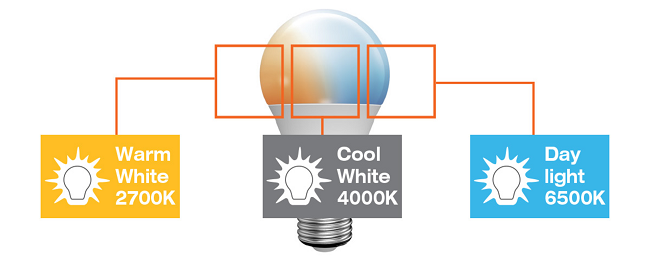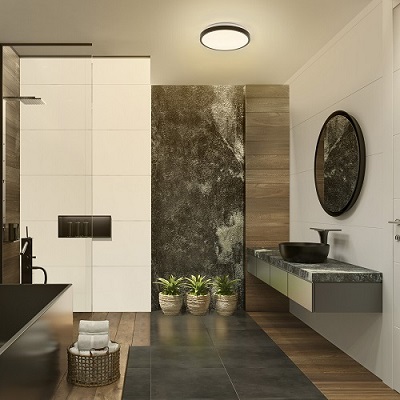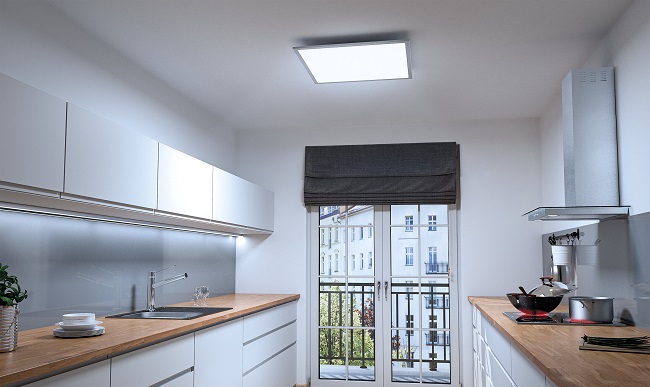Color temperature stands as a pivotal consideration within the realm of home lighting selection, notably impacting not only the visual ambiance of residential spaces but also the emotional well-being and sleep quality of individuals.
We hope this concise overview can function as a comprehensive reference for your
color temperature needs in the lighting industry.

Part 1. The Definition of Color Temperature
Color temperature is a crucial parameter utilized to articulate the visual characteristics and chromatic quality of a light source. In this diverse industry, a wide array of lighting fixtures is available, offering an extensive range of color temperatures across the spectrum of white hues.
One key term often used in lighting discourse is
'Correlated Color Temperature' (CCT), delineates the warmth (yellow) or coolness (blue) of the light emitted from LED bulbs and fixtures. This crucial aspect is measured in degrees Kelvin (˚K), with the Kelvin scale spanning from 1,000 to 10,000 K. A lower CCT value signifies a light source with more pronounced yellow hues, while values approaching the higher end of the scale emulate the qualities of mid-morning sunlight, enriched with blue light wavelengths.
Part 2. What to Consider When Selecting Color Temperature
When selecting LED lighting solutions for your space, it's essential to consider the interplay of light and color. Analyzing the hues of your furnishings, floors, and walls is a crucial step in making an informed choice.
If the predominant color scheme in your residential or commercial space leans towards cooler tones, including blues, greens, grays, blacks, or whites, opting for LED bulbs with a higher Kelvin rating is advisable. A lighting source in the 3,000 K range or higher is ideal in such environments. This selection will integrate with your interior decor seamlessly, providing a harmonious visual ambiance without overwhelming contrasts.
Conversely, if your setting features an abundance of natural materials like hardwood floors, wooden cabinets, wood furniture, and woven fabrics, a warmer color temperature is better. Spaces characterized by reds, browns, oranges, and tans are better suited for LED bulbs with a lower Kelvin rating.
Another often overlooked factor in choosing the right color temperature is aligning with the homeowner or business owner's preferred style. For interiors adorned with traditional decor elements such as crown molding, wooden mantels, wood paneling, and similar components, a product with a 2,700 K rating or lower is recommended. This choice replicates the warm, inviting ambiance associated with lanterns, candles, or incandescent bulbs, enhancing the classic aesthetic.
In contrast, spaces boasting clean lines and a minimalist design may benefit from a cooler Kelvin rating, promoting a modern, sleek appearance. However, it's worth noting that specific areas, such as the bedroom, may still benefit from a warmer light to create a more relaxing environment. Overly cool lighting in sleeping areas can hinder the ability to unwind and rest comfortably.
Part 3. Temperature Recommended By Space
Distinct color temperatures have varying effects on a room's atmosphere. Thus, when deciding on the ideal color temperature for a space, it is advisable to determine the desired mood and ambiance you intend to establish. Keep in mind that cooler color temperatures foster energy and alertness, while warmer color temperatures evoke a sense of relaxation and coziness. The ensuing recommendations are rooted in this fundamental principle.
Bedroom: 2700k - 3000K
Bedrooms are revered as the most private sanctuaries within a home. Optimal lighting, characterized by a softer and warmer ambiance, is highly conducive to fostering a serene and relaxing atmosphere. Such lighting choices contribute significantly to enhancing the overall comfort and tranquility of the bedroom space.
Living Room / Den: 2700k - 3500K
Optimal color temperature ranging from 2700k-3500K can transform your living space into a welcoming retreat, fostering an atmosphere conducive to both relaxation and entertainment. The integration of a dimmer switch further enhances your ability to customize the lighting, creating the perfect setting for activities such as reading, TV viewing, and movie nights.
Bathroom: 3000k - 4000K
For optimal bathroom lighting, it is recommended to employ a versatile combination of illumination. Specifically, bright and cooler lighting is essential for activities such as makeup and shaving, while a softer, warmer light creates a relaxing atmosphere during bath time. Dimmable LED lights offer an ideal solution, providing adjustable brightness levels to meet varying needs.

Kitchen: 2700k - 4000k
Selecting bright lighting in the kitchen is ideal for efficient food preparation and reading recipes. Given the diverse activities in the kitchens, the color temperature requirements can vary. Incorporating dimmable lighting proves to be an excellent solution, allowing for effortless adjustment to different color temperatures that align with various activities in the kitchen.

Home Office: 3000k - 5000k
Implementing bright and functional lighting in the office space is essential for enhancing effectiveness and focus. It is advisable to incorporate a variety of lights to cater to different needs. Bright lights promote alertness and sustained energy, while softer lighting facilitates relaxation and a more serene atmosphere. To cater to diverse needs, it is recommended to opt for adjustable color temperatures ranging between 3000K-5000K in the office area.
Bonus Tips: Some Key Considerations for Quality Lighting
In the realm of home lighting projects, beyond color temperature, several other qualitative factors warrant careful consideration:
Lumens: Lumens indicate the brightness emitted by a light bulb. While
wattage reflects the energy consumption of a bulb, lumens quantify the actual light output.
CRI (Color Rendering Index): The CRI is a scale from 1 to 100 measuring how accurately a light source displays colors in comparison to natural sunlight (rated at 100). A light bulb with a CRI exceeding 90 is considered good, while those surpassing 95 are excellent for vibrant color representation and a more natural-looking interior. Conversely, CRI ratings below 85 can have a dulling effect on surroundings, so it's advisable to steer clear of them.
These factors collectively contribute to the overall lighting quality, ensuring optimal illumination for diverse home environments.



